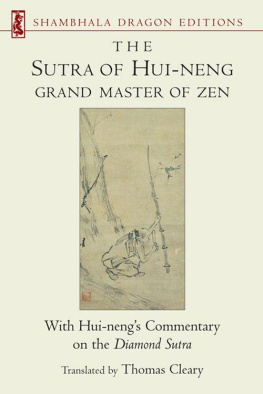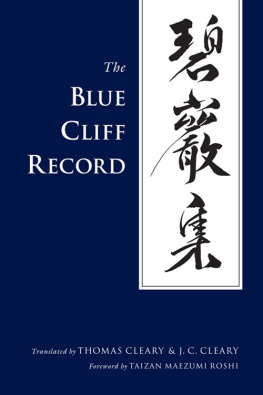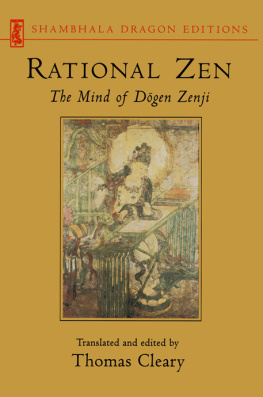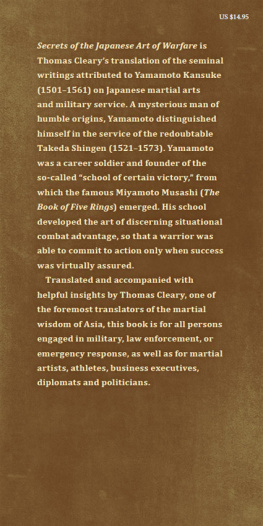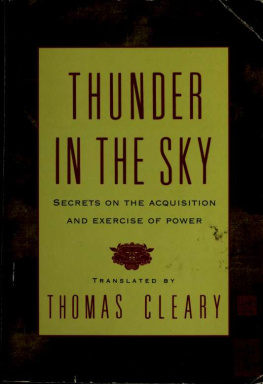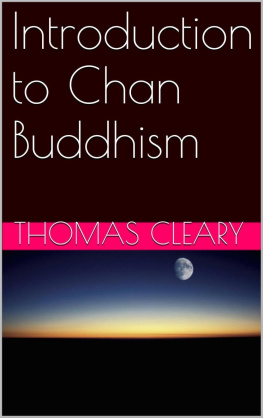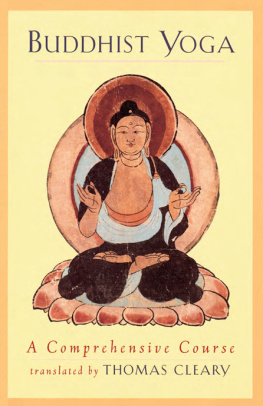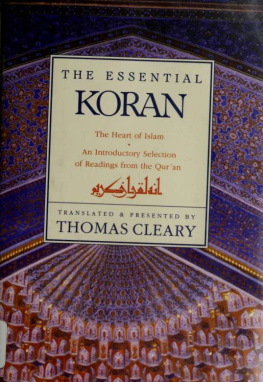Thomas Cleary - The Fifth Council: Buddhism for the Sciences
Here you can read online Thomas Cleary - The Fifth Council: Buddhism for the Sciences full text of the book (entire story) in english for free. Download pdf and epub, get meaning, cover and reviews about this ebook. year: 2015, genre: Religion. Description of the work, (preface) as well as reviews are available. Best literature library LitArk.com created for fans of good reading and offers a wide selection of genres:
Romance novel
Science fiction
Adventure
Detective
Science
History
Home and family
Prose
Art
Politics
Computer
Non-fiction
Religion
Business
Children
Humor
Choose a favorite category and find really read worthwhile books. Enjoy immersion in the world of imagination, feel the emotions of the characters or learn something new for yourself, make an fascinating discovery.

- Book:The Fifth Council: Buddhism for the Sciences
- Author:
- Genre:
- Year:2015
- Rating:4 / 5
- Favourites:Add to favourites
- Your mark:
- 80
- 1
- 2
- 3
- 4
- 5
The Fifth Council: Buddhism for the Sciences: summary, description and annotation
We offer to read an annotation, description, summary or preface (depends on what the author of the book "The Fifth Council: Buddhism for the Sciences" wrote himself). If you haven't found the necessary information about the book — write in the comments, we will try to find it.
The Fifth Council: Buddhism for the Sciences — read online for free the complete book (whole text) full work
Below is the text of the book, divided by pages. System saving the place of the last page read, allows you to conveniently read the book "The Fifth Council: Buddhism for the Sciences" online for free, without having to search again every time where you left off. Put a bookmark, and you can go to the page where you finished reading at any time.
Font size:
Interval:
Bookmark:
The Fifth Council:
Buddhism for the Sciences
By Thomas Cleary
Contents
I. Introduction: Buddhism and the Sciences
II. Faith, Belief, and Doubt
III. Aims
IV. Equipment
V, Elementary Operational Models
VI. Information Organization
I. Introduction: Buddhism and the Sciences
The Avatamsaka-sutra, one of the major scriptures of Buddhism, recapitulates the whole range of Buddhist principles and practices in the form of a symbolic story, a pilgrims journey for enlightenment. Among the guides to whom the pilgrim is directed along the way is a boy called Indriyeshvara, whose name means Master of the Faculties. This boy informs the pilgrim that he has been Taught writing and mathematics and led into the door of knowledge encompassing higher knowledge of all practical arts by Manjushri, Beautiful Light, a symbolic being representing knowledge, insight, and wisdom in Buddhist iconography.
The young Master of the Faculties proceeds to expand upon the curriculum of his studies under Beautiful Light: I know all the various arts and crafts and sciences in the world dealing with writing, mathematics and symbols, physiology, rhetoric, physical and mental health, city planning, architecture and construction, mechanics and engineering, prediction, agriculture and commerce, conduct and manners, good and bad actions, good and bad principles, what makes for felicity and what makes for misery, what is necessary for the vehicles of Buddhas, disciples, and individual illuminates, what is necessary for enlightenment, and behavior linking reason and action. I know all these sciences, and I also introduce and teach them to people, and get people to study and practice them, to master and develop them, using these as means to purify, refine, and broaden people.
Subsequently the pilgrim meets another youth with higher knowledge of arts who uses phonemes to organize ideas. After setting forth his system, this youth says to the pilgrim, I have attained this enlightening liberation with higher knowledge of arts, and it is this I know. How can I know the practice or tell the virtues of those who have attained perfection of all mundane and transcendental arts, inasmuch as they have no barrier, no doubt, no confusion, no uncertainty, no hesitation, no ignorance, no difficulty, no impairment, no frustration, no lack of knowledge, and no misunderstanding in regard to the subject matters of all artsall writing and mathematics, all applied sciences of healing, all the bases of obsession, psychotherapy, epilepsy, lameness, and insanity, the science of compounding medicines, chemistry, mineralogy, the making of parks, groves, villages, towns, and cities, knowledge of the vicissitudes of the world through astronomy, physiognomy, geometrics, meteorology, agronomy, and prediction of trends of events, and the analysis, communication, understanding, and actualization of all supramundane phenomena?
Later on in the journey, the pilgrim meets a girl who tells him a story of a forbear, a maiden of the past representing her ideal: She has perfect knowledge of calculation, writing, symbolism, and technical literature; she has mastered all the arts and crafts in the whole world.. She knows the cause of all illnesses that afflict living beings, and she is able to cure them by correct use of medicines. She has mastered all the different languages of the people on the continent, and the variety of customary usages of society everywhere. She knows the articulation of sounds and the means of differentiation among them, and she is expert in all the songs and dances in the world.. She is always compassionate toward the elderly, toward the sick and the poor, toward the suffering, the blind, and toward the helpless. She is always thinking of the welfare of others, and never thinks of benefit just for herself; seeking the welfare of the whole world, she is adorned with superior virtues of mind.
Another book of the Avatamsaka sutra outlines a scheme of ten stages of enlightenment, a system it calls the alphabet of Buddhism, with which all the teachings are spelled out. Each stage is centered on a specific domain of practice and realization, and supplemented by the other nine. According to the scripture, the fifth stage is centered on the perfection of meditation; at the same time, the scripture says, practitioners in this stage intent on the search for supreme truth, practice whatever in the world would benefit sentient beings, such as writing, teaching, mathematics, sciences of elements, medical sciences, prevention of consumption, epilepsy, and possession; song and dance, drama, music, storytelling, and entertainment; the construction of villages, cities, parks, canals, reservoirs, ponds abounding in lotuses, groves producing flowers, fruits, and medicines; the discovery of gold, jewels, and other precious substances; methods of pointing out the indications of the sun, moon, planets, stars, constellations, movements of the earth, foresigns, dreams, and the characteristics of coordination of general and specific actions and forms of limbs and parts of the body; points of cultivation of discipline, meditation, mystic knowledge, infinite friendliness, compassion, joyfulness, and impartiality, formless states of concentration, and whatever else is not harmful or injurious, that which is conducive to the benefit and well-being of all creatures.
The seventh stage in this system is centered on what is referred to as skill in means or skill in expedients. According to the scripture, Whatever worldly arts and crafts and businesses they do in the fifth stage all operate without effort in the seventh stage. According to another book of the same scripture, their various methods and techniques adapt to worldly conditions to liberate beingswith extraordinary thoughts and profound talent, as cultural royalty, with song and dance, and conversation admired by the masses, all the various arts and crafts of the world they manifest like magicians. Some become grandees, city chiefs; some become merchants, caravan leaders; some become physicians and scientists; some become kings and ministers.. If they see a world just come into being, where the inhabitants dont have the tools for livelihood, they become craftsmen and teach them various skills.
Historical expressions of Buddhist activities in science and technology are not typically labeled Buddhist in the world at large, insofar as conventional concepts of religion and confessional divisions would diminish the scope of their social understanding and integration. In the Mahaparinirvana-sutra , the major scripture on Buddhas final nirvana, the Buddhist Sangha or Community is defined, not as an institution with a particular religious or sectarian association, but as the community of all beings. The notion that Buddhist awakening may be active in the sciences, or that the sciences may foster Buddhist awakening, follows on this foundation; as the Avatamsaka sutra notes, Beings teach, lands teach, all things in all times teach, unceasingly, without interruption.
Scriptures acknowledge that this is not necessarily perceptible to everyone, not even Buddhas disciples. The Avatamsaka scripture goes on at some length to make a point of this, not as a doctrinal issue, but in terms of the bounds of perception, particularly the influence of expectation, training, and orientation on the operation of capacities of perception.
The introduction to the final assembly of the Avatamsaka sutra explains why the scope of the so-called Mahayana or Great Vehicle of Buddhism is not perceptible to people of certain mentalities. To set the scene, the Buddha enters into a state of concentration described as A world-illumining manifestation, of which the body is great compassion, the entryway is great compassion, the guide is great compassion, and the access to the sky of truth is great compassion.
Next pageFont size:
Interval:
Bookmark:
Similar books «The Fifth Council: Buddhism for the Sciences»
Look at similar books to The Fifth Council: Buddhism for the Sciences. We have selected literature similar in name and meaning in the hope of providing readers with more options to find new, interesting, not yet read works.
Discussion, reviews of the book The Fifth Council: Buddhism for the Sciences and just readers' own opinions. Leave your comments, write what you think about the work, its meaning or the main characters. Specify what exactly you liked and what you didn't like, and why you think so.

